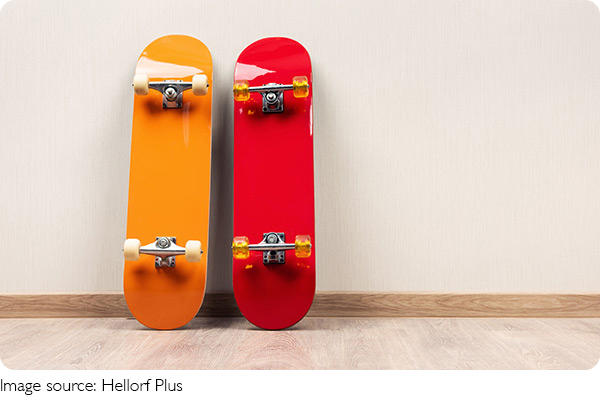Skateboarding for Beginners

So, you're ready to hop on a skateboard and ride like a pro?
Whether you're drawn to the thrill of rolling down the street or mastering tricks, skateboarding is one of the most rewarding and challenging—sports out there.
But don't worry! This guide covers essential tips and techniques to help you start confidently and safely.
1. Pick the Right Board
Before you start, you need the right skateboard. Skateboards come in different types, sizes, and shapes:
- Standard Skateboards: Ideal for street skating and tricks, these boards are typically 7.5 to 8.5 inches wide.
- Cruisers: These have a longer, wider deck and larger wheels, making them great for smooth rides around town.
- Longboards: Longer and more stable, longboards are perfect for those interested in cruising or downhill skating.
For beginners, a standard skateboard is usually a good starting point. Visit a local skate shop to get advice on the best board for your body size and style preference.

2. Gear Up for Safety
Safety is crucial in skateboarding. Here's the essential gear:
- Helmet: Always wear a helmet to protect your head.
- Knee and Elbow Pads: These pads reduce the impact if you fall.
- Wrist Guards: Wrists are one of the most common injury areas, so wrist guards are a must.
- Skate Shoes: Wear sturdy skate shoes with a flat sole to give you a good grip on the board.
3. Master the Stance
Every skateboarder has a stance—either regular or goofy. A regular stance means your left foot is forward, while goofy means your right foot is forward.
4. Learn to Push Off
Pushing off might look easy, but it takes some balance and practice:
1. Place your front foot near the middle of the board.
2. Use your back foot to push off the ground gently, then bring it onto the board behind your front foot.
3. Keep your knees slightly bent, and shift your weight back onto both feet.
4. As you gain confidence, practice pushing off with a bit more speed. Remember, don't rush—mastering balance is key.
5. Practice Stopping
Stopping is essential for your safety. The two main ways to stop are:
- Foot Brake: Take your back foot off the board and lightly drag it on the ground to slow down.
- Heel Drag: Shift your weight onto your back foot, allowing the heel to drag lightly along the ground until you come to a stop.
6. Try the Basics: Turning
Once you're comfortable with riding, practice turning. There are two main techniques:
- Carving: Lean your body weight toward the direction you want to go. Lean left to go left and right to go right.
- Kick Turns: If you need to make a sharper turn, put more pressure on your back foot and lift the front wheels slightly off the ground, then pivot in the direction you want to turn.
7. Don't Rush—Build Confidence Slowly
Skateboarding is as much about confidence as it is about skill. Set small, achievable goals for each practice session. For example, one day, focus solely on balancing; another, work on stopping smoothly.

8. Find a Safe Practice Spot
Beginners should start on flat, smooth surfaces like a parking lot or an empty tennis court. Avoid crowded areas, steep hills, and roads with lots of obstacles until you're confident in your balance and control.
9. Be Patient and Persistent
Learning to skateboard takes time and practice, so don't get discouraged if you fall (which you definitely will). Every skater starts as a beginner, and progress comes with consistency. Make time to practice regularly, even if it's just 15 minutes a day.
10. Join the Skateboarding Community
One of the best parts of skateboarding is the community. Check out local skate shops or parks where you can meet other skaters. Many experienced skaters are happy to offer tips and encouragement.
HOW TO SKATEBOARD FOR BEGINNERS | HOW TO SKATEBOARD EPISODE 1
Video by Braille Skateboarding

 · Sport Team
· Sport Team